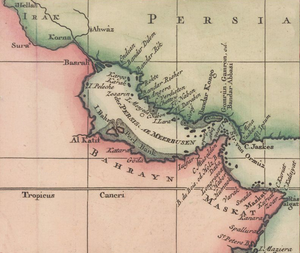User:Shaibalahmar/The Pearling Trade in the Persian Gulf
| This is not a Wikipedia article: It is an individual user's work-in-progress page, and may be incomplete and/or unreliable. For guidance on developing this draft, see Wikipedia:So you made a userspace draft. Find sources: Google (books · news · scholar · free images · WP refs) · FENS · JSTOR · TWL |

Pearling was the principal source of income for many people living in the Persian Gulf region before the advent of oil. As recently as 1938, around 20% of theregion’s population earned their livelihood through pearls.
History[edit]
The pearl beds of the Gulf were renowned throughout the ancient world and remained in the hands of Arabian and Persian princes until the sixteenth century when the Portuguese took control of the most important harbours. Their rule lasted for a century before the Persians regained control. Pearls were traded mostly in the markets of Bahrain and Hormuz before the treasures were shipped by Indian merchants to the major pearl markets of Bombay.
The traditional pearling industry reached its peak between 1850 and 1950 and then began an abrupt decline as cultured pearls, the threat of mechanised diving, a Government of India ban on pearl imports in 1947-1948, and, from the late 1940s, alternative work in the oil industry, took their toll.
Nature of the pearl[edit]
A pearl is a hard, rounded object produced by certain mollusks, such as oysters. The pearl is a valued gemstone and is cultivated or harvested for jewelry. Natural pearls are formed when a small foreign object, such as a parasite, grain of sand, or piece of food lodges itself in the gonad or mantle tissue of a mollusk or oyster. Three species were gathered for pearls and mother-of-pearl: Pinctada radiata, Pinctada margaritifera, Pteria macroptera.[1]
Unlike South Sea pearls, the pearls from Persian Gulf oysters were tiny, generally from 2mm to 5mm in size, but sometimes reaching 10mm. They were often yellowish or brownish in colour. As the Gulf was a major source of pearls in the ancient world it is easy to understand why South Sea pearls when they occasionally emerged through ancient trade routes became so highly prized.
Pearling operations[edit]
The pearling season ran from April to September. Pearling fleets gathered at various ports and were under the comand of an "admiral", or nakhuda, appointed by a local sheikh. One aspect of pearling was the economic exploitation of divers and sailors by the nakhudas. This virtual slavery system led to the Bahrain reforms in 1924-1925, providing for diving rules, accounting methods, registration of vessels and the creation of a hospital ship. By popular demand a diving Court was created in 1928, known as the Barwas Court.
The richest pearl banks were in shallow waters off the coasts of Bahrain, Qatar, and Abu Dhabi (see fig.1). The Great Pearl Bank stretched along the curve of the lower Persian Gulf, and some of the finest pearls lay off Halul Island, sixty miles east of Qatar. The pearling season known al-Ghaus al-Kabir (“The Big Dive”) ran from May to September when a fleet of some 4,000 dhows ranging from the regular sambuk to the larger boum and baghlah would set out from the many ports of the Persian Gulf. Each carried a master, mate, divers, assistant divers and apprentices drawn from those ports, Oman and beyond. Their purpose was to fish for the most valuable pearls. A local dealer recognised about twenty-four varieties of pearl but the large spherical pearl, white, rose-white or of a rose-yellow hue was the rarest of all; and its discovery would cause a sensation among the fleet. As the fleet was on the banks, merchants in their sambuks cruised from dhow to dhow haggling for any pearls they could get.[2]
The sight of these dhows with their lateen rigging under a still blue sky on a placid sea belied the fact that it was a dangerous business. The diver waited on the lowest side of the hull, the sound of creaking timber and gulps of air as the diver prepared to dive overboard. The trick was to expel all the air in his lungs before taking the plunge and then - attached to a rope with rough weight of some fourteen pounds to pull him down - make the jump with a basket in hand and dive to the bottom as quickly as possible. The average dive was 50 to 90 feet but some divers could go to a depth of 152 feet, which could permanently injure them because of the great pressure at that depth.[2]
Demise of the pearling trade[edit]
By 1948-1949 the decline was clearly evident: one report alleged that as few as 50 boats participated in the season. However, outside commercial interest persisted into the 1950s, and as late as 1955 there were vain attempts to impose controls on diving, although the days of the large pearling fleets and inter-tribal clashes had long passed. The industry lingered, much-reduced, throughout the 20th century, its final demise being marked by the official closure of Kuwait’s pearl-oyster market in the year 2000, which brought to an end over 7000 years of pearling in the region.
References[edit]
- ^ Carter, Robert. The History and Prehistory of Pearling in the Persian Gulf. Leiden: Koninklijke Brill NV.
- ^ a b Stanton Hope (1951), Arabian adventurer, London: R. Hale
External links[edit]
- All About Gemstones [1]

